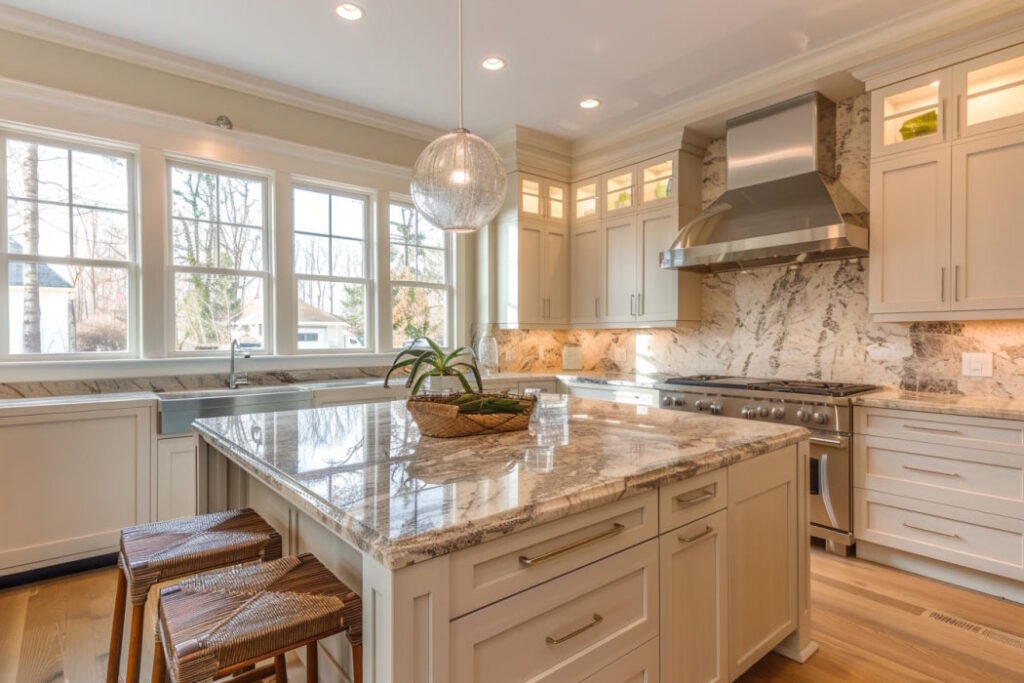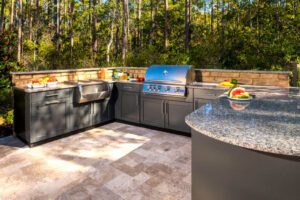Granite countertops have become a popular choice for homeowners due to their beauty, durability, and versatility. These natural stone countertops can add a touch of elegance to any kitchen or bathroom, making them a sought-after option for those looking to upgrade their space. In this article, we will explore the different types of granite countertops available, factors to consider when choosing them, the benefits they offer, popular colors and styles, proper care and maintenance, choosing the right finish, thickness, and edging, as well as finding the right installer and budgeting for your project.
Key Takeaways
- There are different types of granite countertops available, including natural, engineered, and prefabricated.
- Factors to consider when choosing granite countertops include durability, maintenance, and cost.
- Choosing granite countertops for your home can provide benefits such as increased home value and a luxurious look.
- Popular granite countertop colors and styles include black, white, and gray, as well as patterns such as veining and speckling.
- Proper care for granite countertops includes regular cleaning and sealing to prevent staining and damage.
Understanding the Different Types of Granite Countertops Available
When it comes to granite countertops, there are three main types to choose from: slab, tile, and modular. Slab countertops are made from a single piece of granite that is custom-cut to fit your space. This type of countertop offers a seamless and luxurious look but can be more expensive due to the larger size of the slab. Tile countertops are made from smaller pieces of granite that are installed in a grid pattern. This option is more affordable but can have visible grout lines. Modular countertops are pre-cut and come in standard sizes, making them a cost-effective choice for those on a budget.
Each type of granite countertop has its pros and cons. Slab countertops offer a high-end look and can increase the value of your home. However, they can be more expensive and require professional installation due to their weight and size. Tile countertops are more affordable and easier to install, but they can have visible grout lines that may require regular cleaning. Modular countertops are cost-effective and easy to install but may not offer the same seamless look as slab or tile options.
Factors to Consider When Choosing Granite Countertops
When choosing granite countertops for your home, there are several factors to consider. One important factor is color. Granite comes in a wide range of colors, from light neutrals to bold and dramatic hues. It’s important to choose a color that complements your overall design aesthetic and blends well with your existing decor. Another factor to consider is the pattern of the granite. Some granite slabs have a consistent pattern, while others have more variation and movement. The pattern you choose should align with your personal style and the overall look you want to achieve in your space.
Durability is another important factor to consider when choosing granite countertops. Granite is known for its strength and resistance to scratches, heat, and stains. However, some types of granite may be more porous than others, making them more susceptible to staining if not properly sealed. It’s important to choose a granite that is durable enough to withstand the demands of your kitchen or bathroom.
The Benefits of Choosing Granite Countertops for Your Home
There are several benefits to choosing granite countertops for your home. One of the main advantages is their durability. Granite is a natural stone that is incredibly strong and resistant to scratches, heat, and stains. This makes it an ideal choice for high-traffic areas such as kitchens and bathrooms. Additionally, granite countertops require minimal maintenance. They can be easily cleaned with a pH-neutral cleaner and do not require regular sealing if they are properly sealed during installation.
Another benefit of granite countertops is their heat resistance. Granite can withstand high temperatures without being damaged or discolored, making it perfect for placing hot pots and pans directly on the surface. This can save you time and effort in the kitchen, as you won’t need to use trivets or cutting boards to protect your countertops.
In addition to their durability and heat resistance, granite countertops can also add value to your home. They are considered a luxury feature and can attract potential buyers if you decide to sell your home in the future. Granite countertops are often seen as a desirable upgrade and can give your kitchen or bathroom a high-end look and feel.
Popular Granite Countertop Colors and Styles
Granite countertops come in a wide range of colors and styles, allowing you to find the perfect option to complement your kitchen or bathroom design. Some popular granite countertop colors include black, white, and speckled varieties. Black granite countertops can add a sleek and modern touch to any space, while white granite countertops can create a bright and airy feel. Speckled granite countertops offer a unique and eye-catching look with their combination of different colors and patterns.
When choosing a granite countertop color, it’s important to consider the overall style of your kitchen or bathroom. For example, if you have a traditional or farmhouse-style kitchen, you may want to choose a granite with warm tones and subtle patterns. On the other hand, if you have a contemporary or industrial-style kitchen, you may prefer a granite with bold colors and dramatic patterns.
How to Properly Care for Your Granite Countertops

Proper care and maintenance are essential for keeping your granite countertops looking their best. Here are some tips to help you care for your countertops:
1. Use a pH-neutral cleaner: Avoid using harsh chemicals or abrasive cleaners on your granite countertops, as they can damage the surface. Instead, use a pH-neutral cleaner specifically designed for natural stone surfaces.
2. Wipe up spills immediately: Granite is porous, which means it can absorb liquids if left sitting on the surface for too long. To prevent staining, wipe up spills as soon as they occur.
3. Avoid using abrasive materials: When cleaning your countertops, use a soft cloth or sponge instead of abrasive materials like steel wool or scrub brushes. These can scratch the surface of the granite.
4. Seal your countertops: It’s important to seal your granite countertops regularly to protect them from stains and moisture. Follow the manufacturer’s instructions for sealing frequency and use a high-quality granite sealer.
The Importance of Choosing the Right Finish for Your Granite Countertops
The finish of your granite countertops can greatly impact the overall look and feel of your space. There are several different finishes to choose from, including polished, honed, and leathered.
Polished granite countertops have a glossy and reflective surface that can enhance the natural beauty of the stone. This finish is popular for its high shine and smooth texture. However, polished granite can be more prone to showing fingerprints and smudges.
Honed granite countertops have a matte or satin-like finish that is smooth to the touch. This finish offers a more understated and subtle look compared to polished granite. Honed granite is less likely to show fingerprints and smudges, making it a popular choice for those who prefer a low-maintenance option.
Leathered granite countertops have a textured finish that resembles leather. This finish offers a unique and tactile look that can add depth and character to your space. Leathered granite is also less likely to show fingerprints and smudges, making it a practical choice for high-traffic areas.
When choosing the right finish for your granite countertops, consider the overall style of your kitchen or bathroom. Polished granite is often associated with a more formal and elegant look, while honed or leathered granite can create a more relaxed and casual feel.
How to Choose the Right Thickness for Your Granite Countertops
The thickness of your granite countertops can affect both their durability and cost. The two most common thickness options for granite countertops are 2cm (3/4 inch) and 3cm (1 1/4 inch).
2cm granite countertops are thinner and lighter than 3cm countertops. They are often used in situations where weight is a concern, such as in apartments or on upper floors of buildings. However, 2cm countertops may require additional support or a plywood backing to prevent cracking or sagging.
3cm granite countertops are thicker and heavier than 2cm countertops. They offer a more substantial and luxurious look and are less likely to require additional support. However, 3cm countertops can be more expensive due to the larger amount of material used.
When choosing the right thickness for your granite countertops, consider your budget, the overall look you want to achieve, and any weight restrictions or structural considerations in your space.
The Role of Edging in Choosing the Perfect Granite Countertops
The edging of your granite countertops can have a significant impact on the overall look and style of your space. There are several different edging options to choose from, including bullnose, beveled, ogee, and more.
Bullnose edging is a popular choice for its timeless and classic look. It features a rounded edge that is smooth to the touch and can create a seamless transition between the countertop and the rest of the space.
Beveled edging offers a more contemporary and modern look. It features a straight edge with a slight angle or bevel, adding visual interest and dimension to the countertop.
Ogee edging is an elegant and ornate option that features a curved edge with intricate detailing. This edging style is often associated with traditional or formal spaces.
When choosing the right edging for your granite countertops, consider the overall style of your kitchen or bathroom. A simple and understated edging may be more suitable for a minimalist or modern space, while a more ornate edging can add a touch of elegance to a traditional or formal space.
How to Choose the Right Installer for Your Granite Countertops
Choosing the right installer for your granite countertops is crucial to ensure a successful and hassle-free installation process. Here are some tips to help you find the right installer:
1. Check their credentials: Before hiring an installer, make sure they are licensed, insured, and have the necessary certifications and qualifications. This will give you peace of mind knowing that they have the knowledge and expertise to handle your project.
2. Read reviews and ask for references: Take the time to read reviews and testimonials from previous customers. This will give you an idea of the installer’s reputation and the quality of their work. Additionally, ask the installer for references and contact them to get firsthand feedback.
3. Get multiple quotes: It’s always a good idea to get multiple quotes from different installers. This will allow you to compare prices, services, and timelines to ensure you are getting the best value for your money.
4. Ask about warranties: Inquire about the installer’s warranty policy. A reputable installer should offer a warranty on their workmanship to protect you in case any issues arise after the installation.
By following these tips, you can find a reliable and experienced installer who will ensure your granite countertops are installed correctly and to your satisfaction.
Budgeting for Your Granite Countertop Project: Tips and Tricks
Budgeting for your granite countertop project is an important step to ensure you stay within your financial means. Here are some tips and tricks to help you budget effectively:
1. Set a realistic budget: Determine how much you are willing to spend on your granite countertops and stick to that budget. Consider factors such as the size of your space, the type of granite you choose, and any additional costs such as installation or edging.
2. Consider the cost of installation: The cost of installation can vary depending on factors such as the size of your space, the complexity of the installation, and the location of your home. Make sure to include this cost in your budget.
3. Choose a less expensive granite: Granite countertops come in a wide range of price points, with some varieties being more expensive than others. If budget is a concern, consider choosing a less expensive granite option that still meets your aesthetic and durability requirements.
4. Opt for a simpler edge: The cost of edging can vary depending on the complexity and intricacy of the design. Choosing a simpler edge, such as a straight or beveled edge, can help reduce costs without compromising on style.
5. Shop around for the best price: Don’t be afraid to shop around and get quotes from different suppliers and installers. This will allow you to compare prices and negotiate for the best deal.
By following these budgeting tips, you can ensure that your granite countertop project stays within your financial means while still achieving the look and functionality you desire.
Granite countertops offer a beautiful and durable option for homeowners looking to upgrade their kitchen or bathroom. With their wide range of colors, styles, and finishes, granite countertops can complement any design aesthetic and add value to your home. By considering factors such as color, pattern, durability, and overall style, you can choose the perfect granite countertops for your space. Proper care and maintenance, as well as choosing the right thickness, finish, edging, and installer, are also important considerations to ensure the longevity and success of your granite countertop project. With careful planning and budgeting, you can enjoy the beauty and functionality of granite countertops in your home for years to come.
If you’re in the process of choosing the perfect granite countertops for your home, you may also find this article on maximizing space with granite countertops in small kitchens and bathrooms helpful. It provides valuable insights on how to make the most of limited space while still enjoying the beauty and functionality of granite countertops. Check it out here.
FAQs
What are granite countertops?
Granite countertops are made from natural stone that is quarried from the earth’s crust. They are highly durable and resistant to scratches, heat, and stains.
What are the benefits of granite countertops?
Granite countertops are highly durable, heat-resistant, and scratch-resistant. They are also easy to clean and maintain, and can add value to your home.
How do I choose the right granite countertop for my home?
When choosing a granite countertop, consider factors such as color, pattern, and finish. You should also consider the size and layout of your kitchen or bathroom, as well as your budget.
What is the average cost of granite countertops?
The cost of granite countertops can vary depending on factors such as the size of the countertop, the type of granite, and the complexity of the installation. On average, granite countertops can cost between $50 and $200 per square foot.
How do I care for my granite countertops?
To care for your granite countertops, you should clean them regularly with a mild soap and water. You should also avoid using harsh chemicals or abrasive cleaners, and use cutting boards and trivets to protect the surface from scratches and heat damage.
Can granite countertops be repaired?
If your granite countertop is chipped or cracked, it can be repaired by a professional. However, it is important to note that the repair may be visible and may not match the original surface perfectly.





